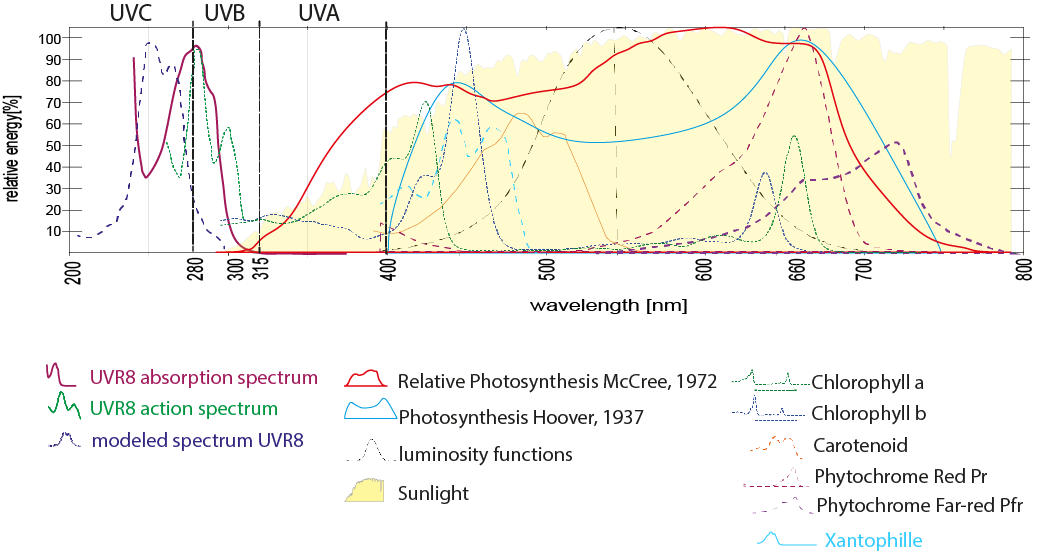Ultraviolet Radiation (UV): A Guide to Growing Healthy Plants
The question about the role of Ultraviolet radiation and its effect on growing plants remain interesting. Most theoretical research has been carried out by analysis of different genetic variants of Arabidopsis thaliana.
While some results may be applicable to other plant species, we point out that this article serves as a meta-analysis of the current available scientific studies. This article serves as a summary of the available scientific studies related to UV radiation.
Electromagnetic Spectrum from UV(C) to Infrared
The picture above shows the Electromagnetic spectrum starting with a wavelength of 200 nm nanometer ( 1nm = 1×10 -9m). The different Classification of relevant radiation for plants like PAR (Photosynthetic Active Radiation) and the extended Version PBAR (Photobiological active Radiation are indicated as well. While PAR mainly focused on Photosynthesis, PBAR aims to include wavelength, relevant for other processes inside the plants.
Key Takeaway:
Ultraviolet Radiation is often used without its classification in UV-A, B and C.
- UV-A: 315-400nm
- UV-B: 280-315nm
- UV-C: 100-280nm
Absorption Curves for Plants from 200 to 800nm

The absorption curves of e.G Chlorophyll a/b partly range inside the UV-A region. Nevertheless, the Blue-light, above 400 nm has significantly higher effects but triggers mainly the same systems.
All UV radiation is considered harmful for humans and plants, UV-C Radiation is the most harmful and therefore often used for disinfection and sterilization. UV-C is also filtered by the earth’s atmosphere, and therefore it does not arrive at the surface and naturally grown plants (in-vivo) never needed to handle or evolutionary adjust to this kind of radiation.
In reference to the table below, coumestrol synthesis, closing of stomata and the production of hydrogen peroxide can be triggered by UV-C but are also effective and the UV-B part of the spectrum.
UVB related processes in plants by specie
| Process | Species | Peak wavelength [nm] |
|---|---|---|
| coumestrol sy nthesis | Phaseolus vulgaris | < 270 |
| H O production in vitro | horse polylgG in vitro | 275 |
| stomatal closing | Eragrostis tef | 275 |
| anthocyanin formation | Daucus carota | 280 |
| CHS gene transcri ption | Daucus carota | 280 and > 330 |
| PAL gene transcription | Daucus carota | 280 |
| cotyledon curling | Brassica napus | 285 |
| MEB5.2 and LHCB1*3 regulation | Arabidopsis thaliana | ~285 |
| PAL gene transcription | Daucus carota | 290 |
| growth inhibition | A. thaliana | 290 |
| anthocyanin formation | Zea mays | 294 |
| flavonoid accumulation | Petroselinum hortense | 294 |
| CHS and PDXI .3 regulation | A. thaliana | ~300 |
| anthocyanin formation | Sorghum bicolor | 302 |
| CsPHR transcription | Cucumis sativus | 310 |
| CsPHR promoter activation | Cucumis sativus | 310 |
UVR8 the UV-B absorbing photoreceptor Protein
UVR8 is the photoreceptor for UV-B radiation like Cryptochromes and Phototropins are for UV-A to blue light and Phytochromes for Red and Far-Red light.
UVR8 senses ultraviolet light between 280 nm 315nm with a peak at lower limit of UV-B at 285nm
Multiple effects are known to be induced by UV-B radiation which are not classified or triggered by defects like the induction of flavonoid synthesis.
Also, some processes are indeed triggered by the plant’s DNA repair mechanis.
As an example, is the inhibition of cell cycle progression and the included cell division induced by UV. This is meant to give the cells time to repair their DNA damage before duplication.
UV-B DNA Repair
Described in common sense: The plant receives harmful UV-Radiation and focuses on protection instead of growth. Based on this: UV-B Radiation will most unlikely increase your yield!
UVR8 action spectrum

Conclusion about ultraviolet radiation for plants
UV radiation plays an important role in growing plants.
- Don’t get misled by the differences in UV radiation and don’t mix it with blue light (>399nm)
- UV-A has mainly the same effect as blue light. But the available LED-Chips usually have lower efficacies.
- UV-C is mainly for disinfection, is not available naturally and is highly harmful.
- UV-B is triggered by the UVR8 receptor and serves multiple functions. Most of them are related to the DNA repair mechanism.
- UV-B can strengthen your plant, but typically does not increase yield due to the inhibition of cell reproduction.
- Most of the available research is based on Arabidopsis thaliana and the results can vary among plant species as well as geno- or phenotypes inside one species.
